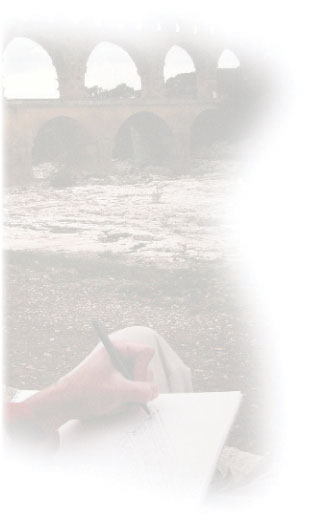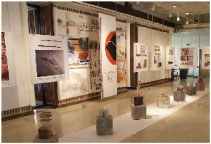
| The College of Architecture and Urban Studies: Shaping the future today by Cathy Watson-Bloch |

| If, as Sir Winston Churchill said, "We shape our buildings: thereafter they shape us," then the College of Architecture and Urban Studies (CAUS) may be summed up in the words of one of the great statesmen of the 20th century. While the college is broadly concerned with shaping or creating the built environment, it also studies how that environment shapes or defines society.
University Distinguished Professor and CAUS Dean Paul Knox says, "We must recognize that the new dynamics of urbanism, along with their new landscapes, cityscapes, and mediascapes, require new approaches to the economic, social, cultural, and professional production of the built environment. New approaches, that is, to both practice and to theory--and, it follows, to some elements of our curricula."
|
 |
Today, the college is dedicated to preparing students for lifelong learning in an ever-changing social, political, and professional environment. It provides opportunities for international and interdisciplinary study, independent thinking, and experiential learning, as well as access to state-of-the-art technologies, infinite research possibilities, and an intellectual environment that emphasizes themes such as sustainability and livability.
With more than 2,000 students and 160 faculty members from 16 nations, the college is among the largest of its type in the country. Nine baccalaureate and 13 graduate degrees are offered in three locations: the main campus in Blacksburg; the National Capital Region in Old Town, Alexandria, Va.; and the Virginia Tech Center for European Studies and Architecture in Riva San Vitale, Switzerland.
The CAUS was founded in 1964 on a vision of the educational value of an interdisciplinary, problem-centered pedagogy, and this approach is still much in evidence in its programs today. The recent restructuring of the university, which added to both the size and the scope of the college, occasioned the addition of the Department of Art and Art History, the addition of the interior design program to the newly formed School of Architecture + Design, and the addition of some of the university's most prominent social science faculty to form a new program in government and international affairs within the new School of Public and International Affairs.
|
| Many of the college's programs are considered among the finest of their type in the U.S. The undergraduate architecture program in the School of Architecture + Design ranks 10th in the nation, according to DesignIntelligence, the only national college ranking survey focused exclusively on design professions. The DesignIntelligence survey ranked landscape architecture 14th nationwide. The urban affairs and planning program ranks seventh in the nation, according to the most recent Gourman Report. And the most recent U.S. News and World Report survey ranked the Center for Public Administration and Policy's master's and doctoral programs at 12th in the nation in public management/administration. Meanwhile, students and faculty from programs across the college have been recognized this past year with countless national and international competition awards and honors.
Additionally, the Department of Building Construction continues to expand rapidly. Its faculty has doubled over the past five years, and today, more than 240 students are enrolled. Career placement for graduating students is near 100 percent, due not only to a strong construction market, but also to academics that prioritize leadership, critical thinking, and managerial skills.
|
 To present its students with hands-on, professional learning opportunities, the CAUS has developed a number of programs. Art and art history's VDS4, or Visual Design Studio, for example, provides a unique studio environment that allows student intern teams to design materials for clients under the supervision of graphic design faculty. Other examples of practical experience include building construction's seminars, field visits, and collaboration with firms in the construction and construction management fields; architecture and landscape architecture's study abroad and institutional exchange programs; and the Community Design Assistance Center's numerous programs. To present its students with hands-on, professional learning opportunities, the CAUS has developed a number of programs. Art and art history's VDS4, or Visual Design Studio, for example, provides a unique studio environment that allows student intern teams to design materials for clients under the supervision of graphic design faculty. Other examples of practical experience include building construction's seminars, field visits, and collaboration with firms in the construction and construction management fields; architecture and landscape architecture's study abroad and institutional exchange programs; and the Community Design Assistance Center's numerous programs.
Also gaining practical experience is the team of students and faculty from several CAUS programs--along with students from the College of Engineering--working to build a fully self-sufficient, solar-powered house for the 2005 Solar Decathlon, an international intercollegiate competition sponsored by the U.S. Department of Energy. The house, which will be transported to the National Mall in Washington, D.C., for final competition in October, will generate enough solar energy to power all the needs of the house and a solar car, including sufficient energy to allow hypothetical residents to run a home-based business. Participants are gaining invaluable teamwork experience while addressing the need for alternative, sustainable energy with creative, innovative housing solutions.
Distinction in research and scholarship is also a hallmark of the college. Knox leads by example--his continuing publication of books and articles on urban and regional development makes him one of the country's most-cited scholars in the field. Research from the Metropolitan Institute at Virginia Tech, an internationally recognized center that researches metropolitan growth and development, has already created a new vocabulary for urban planning concepts--such as "fair growth," "boomburbs," "edgeless cities," "new metropolis," "vulgaria," and "cosmopolis"--that is regularly quoted and discussed by major national media, including The New York Times, The Washington Post, Los Angeles Times, USA Today, and The Wall Street Journal.
Conducting research and outreach for state and local government and nonprofit institutions is the Institute for Policy Outreach (IPO) in the School of Public and International Affairs. Some of the IPO's current work includes partnering with the New River Valley Development Corporation to develop a New River Valley Regional Water Authority and subcontracting with the Partners for Self-Sufficiency to develop and test a wage-advancement program. Overall, college faculty members have attracted more than $7.9 million dollars of sponsored research funding this past fiscal year, placing the CAUS in the top group of similar colleges nationwide.
Addressing the future, Knox says of the college's vision, "Our challenge is to show how and why the design and policy professions matter to contemporary society. Places are becoming increasingly interdependent as a result of economic integration and technological change. The college's particular role within the land-grant university of the 21st century will be to address these interdependencies in ways that speak to civil society, social responsibility, and environmental sensitivity."
For more information about the CAUS, visit http://www.caus.vt.edu.
Cathy Watson-Bloch is the former college communications manager
for the College of Architecture and Urban Studies.
Robin H. Jackson is director of alumni relations for the College of Architecture and Urban Studies.
She may be reached at 540/231-1486 or via e-mail at rhjackson@vt.edu.
|
|
|